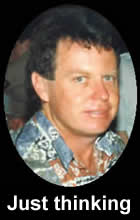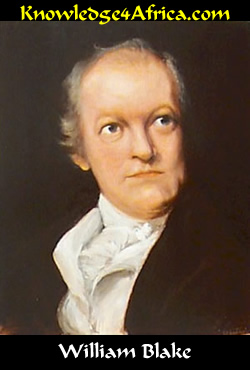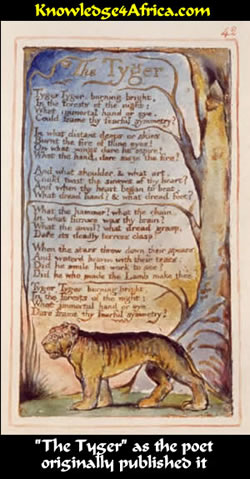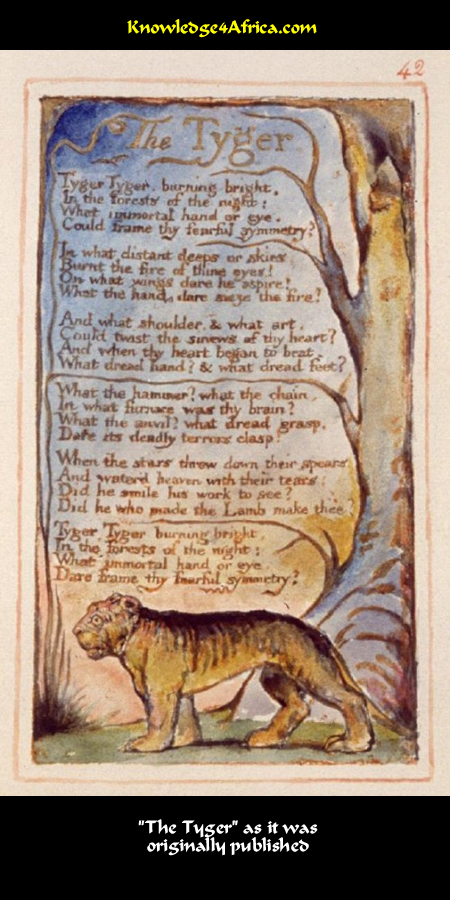|
READ THIS
The poet looks at the power and yet the terror of the tiger and asks questions about its creation.
He uses the image of God as a blacksmith, beating the tiger into existence in the same way as a
blacksmith beats metal into shape.
But, asks the poet, is this the same Creator God as the one who shaped the lamb? Indeed, is this the
same God as the one who is the Father of Jesus Christ?
 ABOUT THE POET
ABOUT THE POET
William Blake was born in London in November 1757. He lived most of his life in that city.
When he was 10 years of age, he attended a drawing school and thereafter made engraving his
profession, graduating from the Royal Academy at the age of 22.
He was then employed as an engraver to a bookseller and publisher, where he was responsible for
creating metal picture plates for making illustrations in books.
In 1783, Blake published his first volume of poems and thereafter established his own engraving business.
This enabled him to publish poetry in a way in which no other poet was doing: by incorporating his text
into engraved picture plates.
This would have remarkable consequences. First, the pictures were artistic renditions of the theme and
were not meant to be accurate. Second, each and every picture appeared in a slightly different shade of
colour so that it is difficult today to determine which colour was the original.
Move your mouse over the picture below to see an example of his engraving for "The Tyger".
Blake's best poems are found in just two collections: Songs of Innocence which he published in
1789; and Songs of Experience although this was not published on its own.
Indeed, his complete works was published in 1794 and was called Songs of Innocence and
Experience Shewing the Two Contrary States of the Human Soul.
Blake was regarded in his time as very strange, if not somewhat mad. In fact, his ideas make more sense
to us today than they did to his contemporaries.
He was a Christian but in a very unorthodox sense. Indeed, he appears to have been what we today call
a Gnostic Christian.
The Gnostics believed in the inner power of wisdom which guides us.
They also believed in two Gods. The first was the God who created material things: like the world, the
animals and humans. The second was the God who created the things of the spirit: like the human soul.
The first God is responsible for all the nasty things in life: like suffering and pollution and dreadful
industrialisation. The second God is responsible for all the wonderful things in life: like salvation, the
human spirit and, of course, Jesus Christ.
Study "The Tyger" carefully. Can you not see the existence of two Gods there? The one God
created the Tyger while the other created the Lamb.
At the time that Blake wrote "The Tyger", people knew very little about wild animals. Perhaps they
might have seen a lion in a circus but almost no-one would have seen a tiger.
A tiger therefore came to represent something to Blake, and it is this that he tries to portray in his poem,
"The Tyger".
But what is he trying to tell us? Is it, in the words of his anthology in which this poem was published,
something about "the Two Contrary States of the Human Soul"?
Blake died in August 1827. He was then 70 years of age.
Have you looked at the questions
in the right column?
|
TEST YOURSELF!
Read the left column and then answer
the following questions:
When the stars threw down their spears,
And water'd heaven with their tears.
- Comment on this portrayal of the cosmos in terms of Blake's vision of the Creator
God. (4)

[Need help?]
These words do not seem to be a portrayal of the traditional Creator God as preached by Christians. They
are more in line with ancient stories from other lands, of cosmological creation stories.
In some of these stories, the stars are formed by the gods throwing down their spears and piercing the
black canopy of the heavens, revealing the fires that burn beyond.
In others, the stars themselves are living entities which, when they cry, water the heavens and the earth
with their tears of rain.
|
Run your mouse over Blake's picture-poem in the column opposite. Would you agree, then, that "The
Tyger" is a magical poem? (4)

[Need help?]
Consider the quaintness of calling the animal "The Tyger" -- alas, lost in modern versions where
it is called simply "the tiger".
Look also at Blake's image of the Creator God as the eternal blacksmith.
Finally, what about the way the artist has drawn each letter "y" in the picture as a series of little
tyger-tails?
Can you see anything else?
|
The poem's language and structure are simple enough, and yet Blake's ideas are complex.
- Explain this paradox. (10)

[Need help?]
The language and style are very simple: six verses and uncomplicated wording.
In fact, many teachers dislike the poem because they believe it lacks substance. The reality, however,
is that the ideas are very complex.
First, the portrayal of the Creator God as the eternal blacksmith, creating the Tyger out of steel.
And then consider Blake's comparison of the Tyger with the Lamb. Yes, it's obvious the Lamb is Jesus
Christ. But isn't that too obvious?
The Lamb also represents "innocence". Consider that the poem "The Lamb" is found in
Blake's Songs of Innocence.
The Tyger, on the other hand, was published in Blake's Songs of Experience and therefore must
surely represent "experience"?
What experience? Life itself? Innocence is ideal but experience is essential -- and it comes through the
harshness of life, a harshness that is depicted by the Tyger.
|
When Blake wrote "The Tyger", the world was in the throes of revolution and violence. The
American and French revolutions had just taken place, and France was in the midst of the "Reign of
Terror".
- Is this reflected in any way in this poem? (10)

[Need help?]
The French Revolution in particular severely affected poets and writers in England.
At first, most were in favour of the revolution because it ousted the autocratic rule of the Bourbon kings
and brought in what looked like a fair constitution, similar to England's.
Then followed the "Reign of Terror" which caused shockwaves through England.
It is possible that Blake is hinting at this in his poem, comparing the innocence of the ideal life with the
harshness of the reality. And that, says Blake, is what life is all about.
Innocence is an ideal but one can only grow to maturity through the savage onslaught of experience.
The Lamb and the Tyger are therefore two opposite sides of life -- but life created by the same God and
for the same purpose. Or was it?
|
What immortal hand or eye,
Could frame thy fearful symmetry?
- Is there any significance to the fact that the word "symmetry" does not really rhyme with
"eye"? (2)

[Need help?]
Perhaps. Blake's poem is so ordered and so well structured. The rhythm is well pronounced to create
the image of the blacksmith God.
And yet, into this ordered universe comes disorder and disharmony -- portrayed by the clear lack of
rhyme in "symmetry" and "eye".
Or is it simply a case that, in Blake's day, "symmetry" and "eye" did indeed rhyme?
|
Is Blake using the Tyger as a symbol for anything? If so, as a symbol for what? (10)

[Need help?]
The answer to this question would appear to be given by Blake himself when he compares the Tyger with
the Lamb.
One has to be aware the Blake wrote another poem called "The Lamb" which is found in his
Songs of Innocence.
The Lamb obviously alludes to Jesus Christ, but it is also a symbol for innocence. The Tyger, on the other
hand, is the exact opposite. It is the opposite of Jesus Christ but, more importantly, it is the opposite of
innocence.
This is indicated by the fact that the original "Tyger" was published in Blake's Songs of
Experience. Is not the Tyger then a symbol for "experience"?
And so the Lamb and the Tyger are juxtaposed to portray the essential opposing forces in life.
|
|





